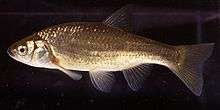Iberochondrostoma olisiponensis
Iberochondrostoma olisiponensis, the Lisbon arched-mouth nase, is a freshwater fish discovered in 2007 in the lower Rio Tejo basin, Portugal.
| Iberochondrostoma olisiponensis | |
|---|---|
 | |
| Scientific classification | |
| Kingdom: | Animalia |
| Phylum: | Chordata |
| Class: | Actinopterygii |
| Order: | Cypriniformes |
| Family: | Cyprinidae |
| Subfamily: | Leuciscinae |
| Genus: | Iberochondrostoma |
| Species: | I. olisiponensis |
| Binomial name | |
| Iberochondrostoma olisiponensis (Gante, C. D. Santos & Alves, 2007) | |
| Synonyms | |
| |
Identification
The Lisbon arched-mouth nase is a small cyprinid. Adults range from 5 to 11 cm, though there are records of specimens reaching ca. 18 cm. It can be distinguished from the other Iberian nase species by the lack of horny blade on the lower jaw, the absence of intense reddish coloration at the base of the fins and by its pronouncedly arched mouth. It has elongated pelvic fins that reach the anus and often pass the anal-fin insertion in males, and dorsal, pelvic and anal fins usually have 8 branched rays. This species has 36 to 43 scales in the lateral line, 7.0 to 8.5 scales above the lateral line, 13 to 16 circumpeduncular scales, denticulated (vs. smooth) grinding teeth surfaces, 6-5/5 pharyngeal teeth and 15 to 19 gill rakers. It is further distinguished from Iberochondrostoma lusitanicum, a phylogenetically close species that lives in the same area, by having a higher body, a relatively longer head, and a larger eye. The origins of anal and pelvic fins are displaced anteriorly, while the origin of pectoral fins is displaced posteriorly. Pelvic and pectoral fins and last anal-fin ray are longer in the new species. Unlike the other phylogenetically related species, the Lisbon's arched-mouth nase shows external sexual dimorphism, with males having longer pelvic fins whose extremities pass the anus and often overlap with the anal fin.
Origin
It was estimated from a molecular clock that the species had split 7•9-12•5 million years ago (middle–upper Miocene) from its most recent ancestor. This period coincides with a phase of endorheism in the Iberian Peninsula.
Distribution
This species is endemic to the lower Rio Tejo basin. It was only found in three tributaries of the Tejo River, namely, Trancão, Maior, and Muge.
Conservation
The Lisbon's arched-mouth nase was found to be locally rare. Additionally, its distribution is limited to an area of high human impact on water resources, through water extraction for agriculture, introduction of exotic species, water pollution and land reclamation, which pose serious risks to its survival.
The species has been placed in the category Critically Endangered B1ab(i,ii,iii,iv,v)+2ab(i,ii,iii,iv,v) according to IUCN criteria.
References
- Gante, H.; Santos, C.D.; Alves, M.J.; Rodrigues, J. (2012). "Iberochondrostoma olisiponensis". The IUCN Red List of Threatened Species. 2012: e.T13160676A13160751. doi:10.2305/IUCN.UK.2012-1.RLTS.T13160676A13160751.en.
Gante, H. F., Santos, C. D., Alves, M. J. (2010) Phylogenetic relationships of the newly described species Chondrostoma olisiponensis (Teleostei: Cyprinidae). Journal of Fish Biology. 76, 4, 965-974.
Gante, H. F., Santos, C. D., Alves, M. J. (2007) A new species of Chondrostoma Agassiz, 1832 (Cypriniformes : Cyprinidae) with sexual dimorphism from the lower Rio Tejo Basin, Portugal. Zootaxa. 1616, 23-35.
Gante, H., Santos, C. D., Alves, M. J., Rodrigues, J. (2012) Iberochondrostoma olisiponensis. In: IUCN 2012. IUCN Red List of Threatened Species. Version 2012.2. <www.iucnredlist.org>. Downloaded on 2 June 2013.
External links
- Froese, Rainer and Pauly, Daniel, eds. (2012). "Iberochondrostoma olisiponensis" in FishBase. December 2012 version.
